How To Build A Sales Funnel That Sells
Guide them through these 4 Sales Funnel Stages
Creating a sales funnel is much like dating. It happens in stages.
You don’t try to get her in your bed on the first date.
You don’t ask what their five-year plan is after two dinners.
You don’t give him/her the key to your place after a couple of sleepovers.
You don’t propose when you’ve only known each other for three months.
Building meaningful relationships takes patience, generous nurturing, hard work and time. We all know that.
Customer relationships are no different.
Have you ever bought something off a dead cold email from a total stranger? Have you ever bought something off a Facebook Ad the very first time you laid eyes on it?
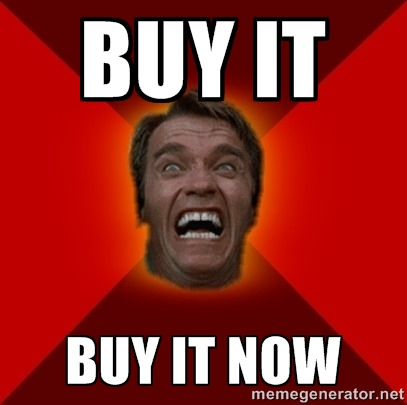
Way too often do I see sales people and marketers bombard people they don’t know with sales pitches for products they don’t need.
And no: customising first name, last name and company name in your automated cold email doesn’t count as personalisation.
The goal of marketing is not to make sales. The goal of marketing is to build value-based relationships with an audience. A sale is merely the logical consequence of such a relationship.
Without a relationship, there can be no sale. A sale is your lead acting on their trust in you to solve a problem they’re having, to reach a goal they care about.
It’s the equivalent of your better half committing to a long-term relationship with you. That stuff doesn’t happen overnight.
The marketing equivalent of the process that sees you trying to win the heart of that special someone is called a sales funnel.
Like dating, the first vacation together, meeting the parents, moving in together and eventually committing, the sales funnel is a multi-step, multi-modality steps that gets prospects from not knowing nor you nor your product/service to buying that very product/service.
The sales funnel is the actualization of the wisdom that you should never sell at first sight. Other than your prospect having the problem you can solve, the one factor that drives this transformation process is trust. To get from lead to deal, you need to get your prospect to trust you and finally act on that trust.
There’s different models to conceptualize this process. The traditional version outlines four sales funnel stages going from awareness to interest, decision and finally action. Growth hacking teams prefer Dave McClure’s pirate funnel, portraying awareness, acquisition, activation, retention, referral and revenue as the six sales funnel stages a customer goes through on his buying journey.
For the sake of keeping it simple, we’re going to stick to the basics while defining a template:
- awareness: the prospect learns about your existence
- interest: the prospect checks out your value
- decision: the prospect decides they trust you to solve their problems and acts on that trust by taking a purchase decision
- long-term relationship: the prospect has become a customer
People learn about you, they check you out, they make the decision to become your customer and stay your customer. As a marketer, you’re responsible for getting a prospect to learn about you, getting them to check you out, driving them towards them towards commitment and honoring that commitment for a longer period of time. Sounds a lot like the stages of your love life, doesn’t it?
#1. Awareness
As with dating, you’re starting out from a position where you and your prospect don’t know each other. You do — or should — however have a clear-cut idea of who your type is, who your buyer persona is. These are the people you know you can provide value to. Showing them that you can is what will enable you to build trust and establish a relationship.
This is the stage where they enter your sales funnel.
Conceptually, there’s two ways this can happen. Either your prospect comes to you (inbound) or you go to your prospect (outbound).
Outbound is what most people know as traditional marketing: tv, radio, direct mail, billboards. Digital examples of outbound marketing include PPC, banner ads and cold email. It’s pushy, unaligned, impersonal and doesn’t take the context of individual recipients into account. The idea behind this kind of online marketing is if a large enough audience is reached, a small minority will identify with your message and convert. Small, but big enough to make it worth the investment. You push answers and hope to capture people that have the questions.
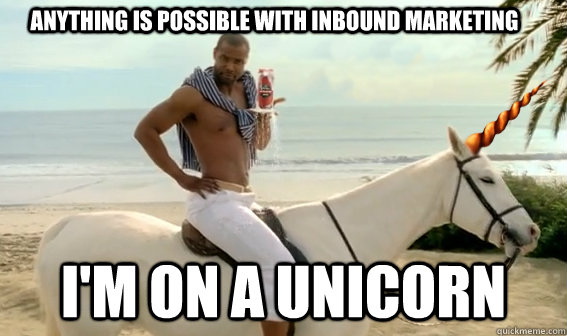
Inbound turns that idea upside-down. It’s prospects acting to solve their problems and ending up on your doorstep because you have the answers. As an inbound marketer, it’s your job to make it easy for people with questions to find your answers. You do this by finding out where they look and being there with your value (SEO, social media).
Forget inbound and outbound. Focus on giving value.
For many people outbound marketing and spam are two names for the same thing and understandably so. Unsolicited emails with content that’s not relevant doesn’t do anything but waste your time and energy. They’re stealing your attention and you don’t get anything in return.
Back when I was still in my marketing diapers, I’d sent out cold emails blatantly pitching Salesflare to unsegmented lists, asking recipients to check it out and get back to me with feedback. This won’t come as a surprise to you: no one replied.
Why would they? Who in their right mind would take out valuable time out of their day to do something for someone who’s a total stranger to them?
Especially if that stranger is clearly a marketer.

Now watch what happens if you send them something that is worth their time, like a piece of content that directly addresses a problem they’re struggling with in their business or an invite to your Facebook community with lots of people like them. That last one tends to work particularly well: it takes little effort to join a Facebook group and getting a personal invitation makes people feel special. Once in your group, they’ve effectively entered the first stage of your sales funnel.
Are you selling marketing automation software and targeting founders from design agencies with around 20 employees? Send them an article with actionable tactics they can use to get more clients. Or what about an interview with a founder of a design agency that doubled its business over the last year? I know I’d want to read that if I were a design agency founder.
Will everyone reply to your email now? No. You’re still targeting people you don’t know anything about other than superficial characteristics like role, industry and company size. Their unique context is unknown to you and that context may still cause them to reject you or at least not reply. Not every girl or guy you’re asking out is going to say yes, even though you have some many shared interests — but hey, they can’t blame you for trying.
Even if they don’t reply, by offering relevant value you drastically reduce the risk of people resenting you for sending them something they didn’t ask for. There’ll always be people who want to bitch about it, but overall you’ll have made a positive first impression with your brand.
This is another way of thinking about inbound and outbound.
Once you have value that is relevant to your audience, it’s merely about who the conversation starts. You can make it easy for people to find it (inbound) or you can offer it to them (outbound). Or both. The point is that neither one is going to work if you don’t have content that is of value to the people you’re targeting.
Know your audience
To know what kind of value you should create, you first need to know what is of value to your target audience. This takes empathy and diligence. This takes being wherever your audience is and putting yourself in their shoes.
Never before in history has that been so easy as it is today. Social media is like real-time market research: people will come out and express their problems, pains, struggles, wishes and desires. You just need to be there and keep your ears open.
Aside from immersing yourself in online tribes, you can look at a site like AnswerThePublic to find out what kind of questions people are asking around a given keyword. Here’s a peek at questions revolving around the keyword ‘CRM’:
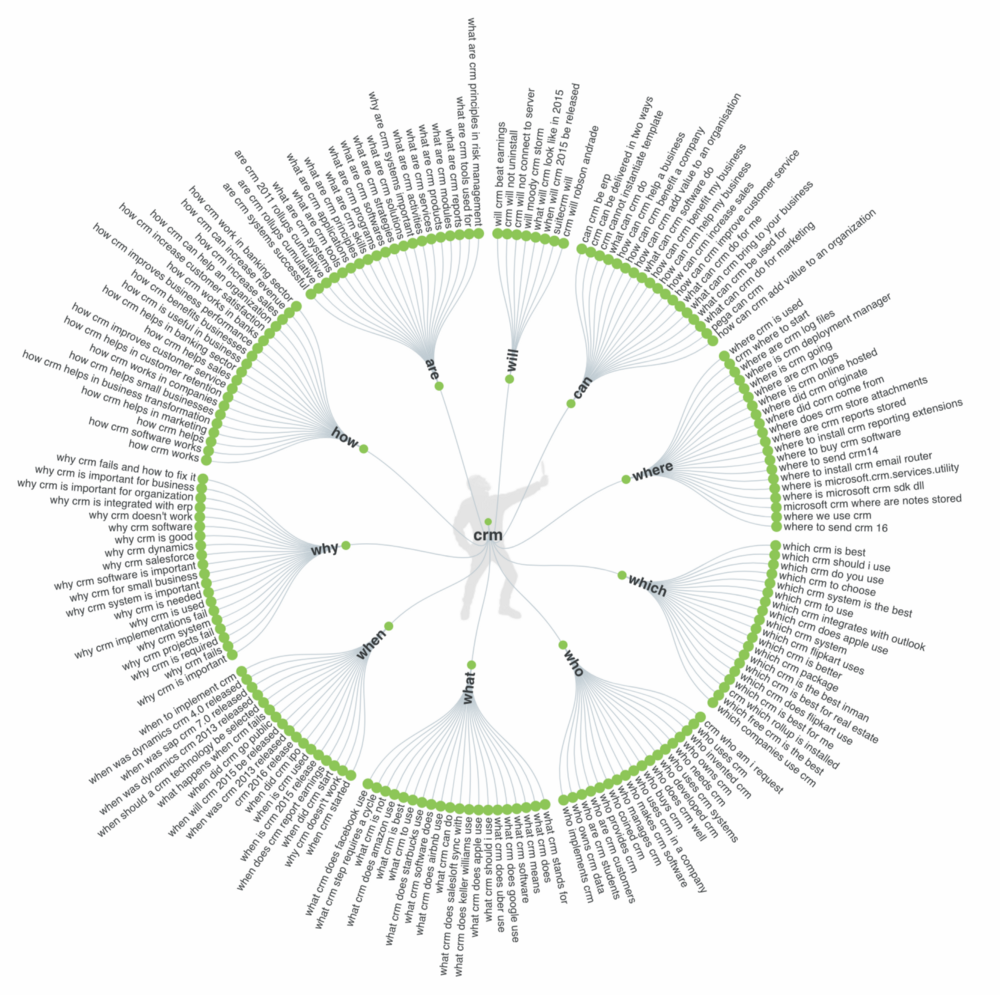
Another great resource to find out what people want to know is Quora.
When starting out at Salesflare, we’d get tons of leads from simply answering to CRM recommendations asked on Quora. People asks questions of all sorts on there and that makes it a great inspiration for content creation.
While view and follower count provide a good indication of how sought-after a question is, the best way to identify valuable topics on Quora is to link them to SEO keywords and check the search volume.
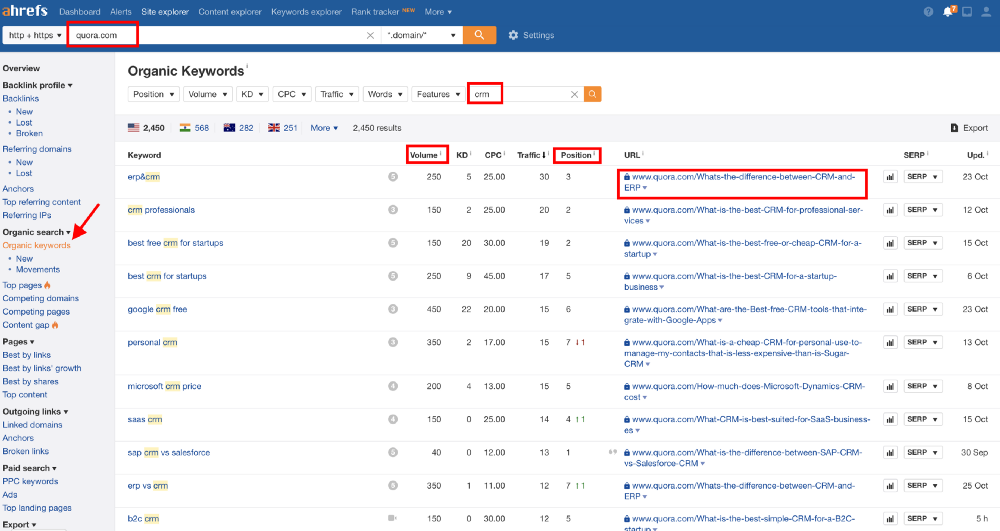
Using an SEO tool like Ahrefs, Moz.com or SEMrush, you can track down the questions the most sought-after Quora questions as shown in the screenshot. You can also do this for Reddit, another place on the internet that can give you loads of inspiration on what value to create.
Ultimately, the best way to find out what is of value to a group of people is to become part of that group of people. It’s no coincidence the best entrepreneurial stories start with founders scratching their own itches. If you yourself are part of the target audience, you’ll know exactly what kind of value is needed. Friends make very good customers.
Creating content and promoting it are two very different things
Marketing has finally caught up with understanding that targeted value beats unsolicited ads. Competition in the organic content marketing space is growing fierce. Great content isn’t going to read itself the same way great products don’t sell themselves. If you want eyeballs on your value, you need a strategy.
The money is in lists. The bigger and more targeted your lists, the more people will read and share your content, fueling its spread and unique traffic.
- Email list
- Facebook chatbot list
- Retargeting list
If you’re not building a Facebook chatbot list, now’s the time. Messenger is the lowest-threshold medium to deliver content through right now. Its open rates make your emails’ look ridiculous but they will go down as more businesses start to use it. If you jump on the train today and build up a big fat list by the time that happens, you’ll beat everyone else who didn’t. Apps like Chatfuel and ManyChat make it dead easy to build a chatbot without coding in minutes so no excuses there.
Your retargeting list isn’t going to get you a lot of unique traffic but it will get people to buy, which is the whole point of doing content and basically anything else anyway.
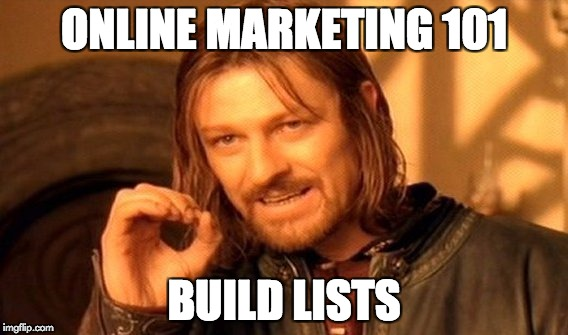
Technically, list building happens further down the sales funnel stages. They’re about capturing interest, which awareness is meant to trigger. You can build lists without having your prospects approval (opt-in), but I don’t recommend this. This takes you down to the level of unsolicited mass cold emailing, a.k.a. throwing $#*! and see what sticks without caring what the people you threw $#*! at now think about you.
The reason we need to talk about lists already is that they’re an essential building block of your content promotion strategy and thus key to triggering word-of-mouth over the internet. Getting new people to read your content passes through the ones that are already likely to dig and share your it.
We’ll go over capturing interest and getting people to sign up for your email list in a bit. First you’ll want to focus on distribution strategy that triggers interest of more people so more people sign up to your lists.

As soon as you finish a new piece of content, go all out on distribution.
- Send it out to your email list. State that it’s an article in the subject line and make a short introduction. And remember: you’re sharing, not selling.
- Send it out to your Facebook bot subscribers. Same idea.
- Run your content as Facebook Ads to any audience that may be relevant. This is how you beat hundreds of thousands of other pieces of content battling for your audience’s attention. Use paid traffic to fuel organic traffic and build your lists.
- Repurpose your content. Quora answers, Reddit threads, LinkedIn posts, tweets, Google Docs in Facebook Groups, microblogs on Instagram: wherever your target audience is and whatever floats their boats.
- Submit your content to relevant directories with big audiences. In my case this is GrowthHackers.com and Zest.is. Zest is a Chrome extension for marketers with curated articles.
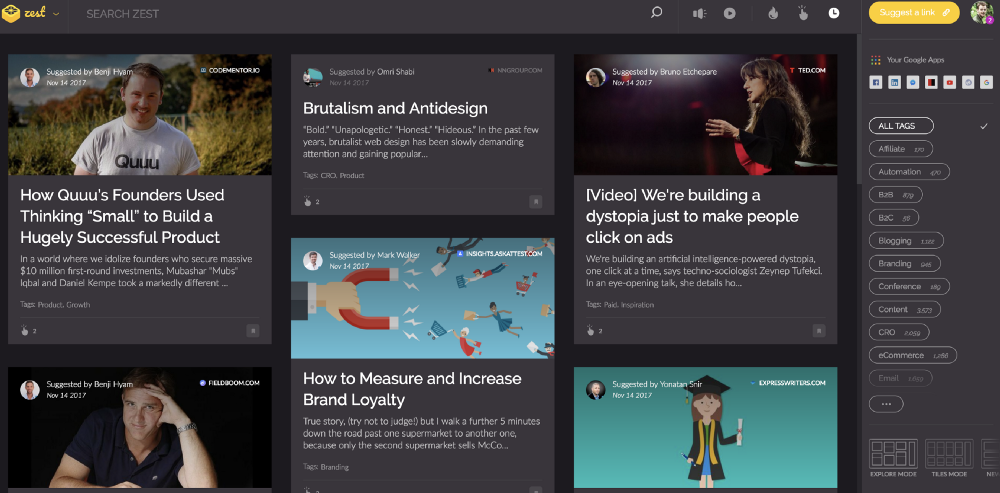
6. See the guy on the top-left? That’s Daniel Kempe, the founder of Quuu. You can use Quuu to automate sharing great articles relevant to your niche on your social media channels. The articles that get into your feed are curated from the input the guys at Quuu get from QuuuPromote. If you want your articles to be automatically shared by influencers from all over the world, submit your article there.
Become a familiar face
People often say they see my content everywhere.
They mean that in a good way. At least I think they do.
This is no coincidence. I designed it to be that way.

Put a face to your content by being everywhere your target audience is. People buy from people they know, like and trust — give them the opportunity to build that kind of relationship with you. Serve your helpful content with a friendly face.
I connect with prospects on LinkedIn. I also follow them on Twitter and on Quora, lots of them follow me back. Now everywhere they look, they’ll see my face. And my content.
Sounds a bit stalky? Maybe. But don’t underestimate how special people feel when they see that notification telling them someone’s following them. Besides, platforms like LinkedIn were conceived for this purpose: to make business personal. Growing an online network is about connection, value and nurturing. The principles of human rapport building apply everywhere.
You can avoid being weird by letting them take the first step. Only connect with people who have given you some kind of signal your value resonates with them: a reply to an email, a subscribe to your email list, a like on your Facebook page. If they’ve done any of these things, they’ll know who you are and they’ll appreciate you wanting to become friends on social media.
One of the best pieces of advice I can give you here, is to treat every profile you have on the internet as a landing page. Similar to how you optimize landing pages to get people to sign up or perform another kind of action, you can optimize your landing page to maximize follow-back ratio. Make people want to hit that ‘Follow’ or ‘Connect’ button when they land on your profile. This is about headline, tagline, profile picture, background picture and everything else you have available on a particular profile page. Establish yourself as a giver, a helper, a creator without diluting your own personality. Above all, you need to come across as authentic and valuable.
If you don’t feel like going through the trouble of going to LinkedIn, look up your prospect, hit ‘Connect’ and write a note — you can automate sending LinkedIn invites to people you’ve emailed with by connecting your business email from the ‘My Network’ tab.
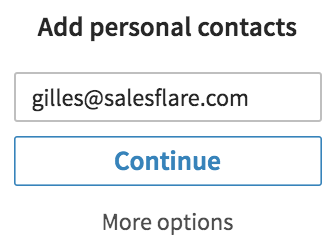
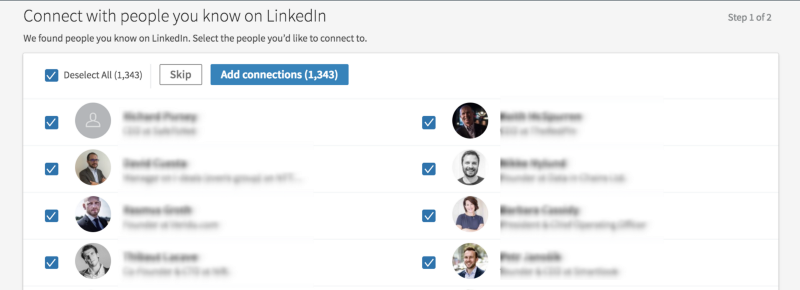
Periodically automating this may however cause you to lose momentum with a prospect. Reaching out after an email exchange solidifies the young relationship and keeps your prospect warm. A little trick that can help out here is to link your LinkedIn in your email signature. You’d be surprised how many people will click it.
In case you want to turn it up a notch: most people that are active on Twitter list their profile on LinkedIn so you can follow them on Twitter in about two clicks.
Note that if you’re going to be everywhere, you better make a good impression. Establish yourself as a helper and a giver. Someone people can easily connect to. Being all over their news feeds isn’t a good thing if they think you’re in it to take something from them (sell to them).
Now that we’re on the subject: don’t you ever dare to unsolicitedly pitch your business to prospects on LinkedIn.
Once someone is in your LinkedIn network, you can also nurture them on Facebook running ads with your content.
Click your avatar and head to ‘Setting and Privacy’. From Account > Account, choose ‘Download your data’.

You’ll get an export with all sorts of stuff, amongst which all your connections with their primary LinkedIn email addresses. You can turn these into a custom audience to run Facebook ads to.
Consistently providing value on different platforms at the same time is a great way to quickly build up your know, like and trust factor. You’ll stop being the gazillionth founder that wants to desperately sell his beloved baby product and become recognized as someone people can trust to solve a particular problem.
Establishing personal social media connections with prospects in the awareness stage of the sales funnel helps trigger people’s interest in your product or service. Once the interest is there, you’ll already have a connection in place to develop into a relationship. A customer relationship, for example.
Automate your reach
A question people often ask me is how they can pull off creating great content consistently.
The answer is simple: automate everything else.
In order to go all-in on mindful work like creating value and building human connections, you need to outsource as much mindless work as possible. Technology like automation and auto scheduling software has matured up to a point where it doesn’t need your supervision anymore. Take advantage of that. Have the robots take care of the robot work so you can focus on stuff that matters.
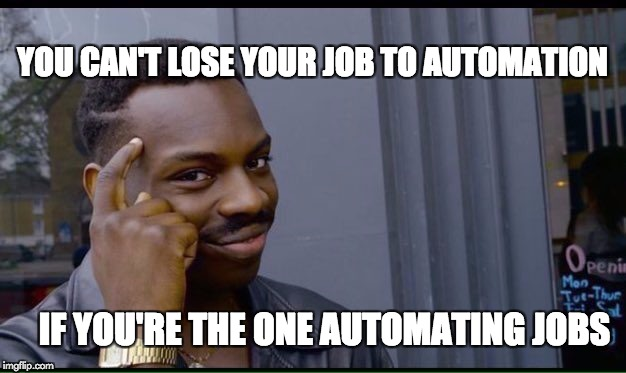
The one tool you should know about here is Zapier.
Zapier allows you to connect a whole bunch of apps (750+) and make ’em work together without you having anything to do with it. Just tell it what you’d like it to do.
The idea is pretty simple: each app has a series of triggers and series of actions. You can create a flow where a specific trigger in one app triggers an action in the other one.
Such an automatic flow is a ‘Zap’.

What to automate? Everything that doesn’t need your human touch.
This notion goes beyond the sales funnel stage of awareness. It’s valid for everything in your business, your life even.
We of course use Salesflare (straight from the CRM) to automate our email outreach. In a manual world, we’d have to feed leads by importing. CSV files with data every time again. You can just as easy have Zapier take care of this for you.
The most basic example here would be to use Zapier to hook up your Salesflare contacts to a Google Sheet. Every time you’d add a lead to the Google Sheet, it will be added as a Salesflare contact with a specific tag and the email workflow will start.
A more advanced example: connect an email finding tool like VoilaNorbert to Salesflare and trigger the creation of a new recipient in a Salesflare email workflow each time VoilaNorbert found a new email address.
Tread carefully when you’re doing email automation however. Email automation tools can personalize the copy of your emails using data like name, company and more but just getting someone’s name right isn’t quite what ‘personalization’ is about. Most people stop there and then act all surprised that their emails aren’t working.

Personalization is about getting the right value and message to the right person. If you want to rhyme getting a piece of content outlining how design agency founders can get more leads to actual design founders with email automation, you’re going to need to segment your list thoroughly. Segment lead lists on characteristics like role, industry, company size and then match these lists to a piece of value that is perfectly aligned with them. That’s how you get the right value to the right person. That’s how you properly personalize an automated email.

Further up in the sales funnel stages, but worth mentioning while in the realm of automation: use Zapier to set up a meeting scheduler (like YouCanBook.me or Calendly) to capture leads if they end up booking a meeting with you and then have these leads automatically pushed into Salesflare or another CRM, all ready for efficient follow-up. For more inspiration on this, check out our post on The Subtle Art Of Following Up With Automation.
Here’s another one: send out automated emails to customers giving you a NPS-score of 8 and higher, asking them if they would like to write a review on a review website or Product Hunt. Growthscore.io is NPS-software that has this feature built-in.
Think beyond processes that are directly linked to your sales funnel: anything that doesn’t need your own personal attention and talent is eligible for automation. It’s all about freeing up time for stuff that really matters: creating value and building meaningful relations.
If you’d like to automate something but can’t see how, you can always hire a freelancer to do it for you on Upwork. There’s tons of talented people from all over the world who’d love to work with you.
#2. Interest
Somebody clicked on your link and is now on your landing page.
Whoa!
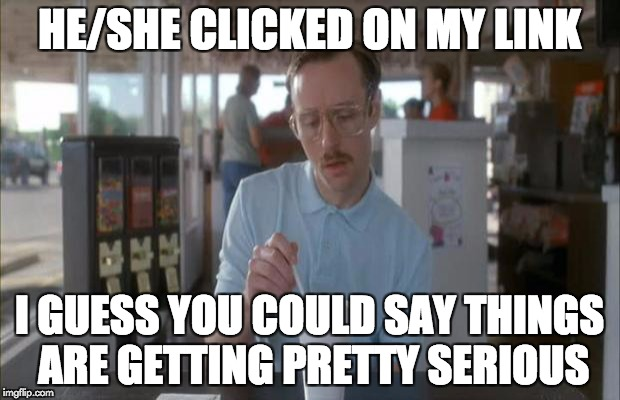
Not so fast.
A prospect clicking through to your landing page is like a first date. It’s great that they agreed upon that first date, it shows interest. But the game is only just beginning: you now have a shot at proving that interest is justified. Your price: their permission to contact you again for more value: a new date, a new piece of content, an offer. Whatever you want to call it.
What you’re after is the marketing game’s equivalent of getting someone’s phone number: their email address. Interest only becomes real once you manage to capture it.
Build an email (or chatbot) list
An email list is so much more than just a list with email addresses you can send messages to. It’s your audience, your fan base, a life line that helps you thrive when times are good and keeps you above the water when times are bad. Empires have been built on email lists.
When people opt-in to your email list, they give you the permission to contact them with value. It’s them effectively entering the first stage your sales funnel. The game is on.
Building email lists is typically done using lead magnets. This is where you trade in value for email addresses, also known as the ‘want access to my FREE ebook on making a million dollars in one day?!’ tactic.
The problem with bombarding people with such a lead magnet is that it can feel deceptive. The title may sound great but that doesn’t guarantee the value behind it, is too. If your leads gives in and gives up their email address to then discover the content doesn’t deliver on its promise at all, they’ll feel tricked.
This is the clickbait phenomenon.
Yes, you’ll have their email address but instead of capturing interest you have now sown aversion, making that email address utterly useless. And if they did like the value, there’s no way to know — you’re in the dark either way.
You can be more subtle. Notice how Sumo.com tries to get people to opt-in to their email list from this great article on Intercom by offering them bonus content.
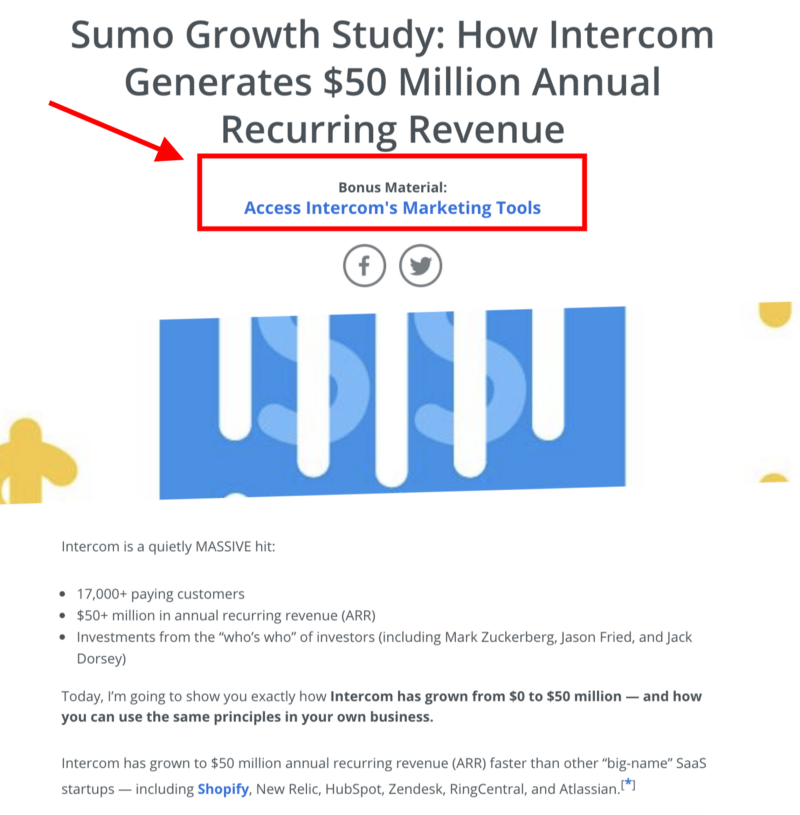
The article in question is an awesome breakdown of Intercom’s marketing tactics. They give you an inspiring story with tons of takeaways you can use in your business but leave out the cherry on top of the pie. Not only is this way more effective in building up your goodwill, Sumo’s marketers can also rest assured that people really did think the value they got from Sumo was great. Their interest is as real as it can get and deserves to be captured.
It doesn’t always have to be an article, whitepaper or ebook. One of the greatest lead magnet examples of all time is HubSpot’s WebsiteGrader, an online tool that assesses the quality of your website and turns its findings into free advice on how to get it right. Since its launch in 2006, this gimmick has graded over 4 million websites. Getting HubSpot not just a huge email list, but also a lot of valuable data that can be used to identify and qualify prospects.
Or you can just keep it simple and put engaging CTAs to ‘never miss anything’ on strategic places, next to that great content you’re consistently putting out.
The email list of the future looks like a chatbot list. Prospects can sign up to it by clicking a CTA like the one below (not a real one) and get your updates automatically in their inbox.

As a channel, it has less friction than email. For some reason, people seem to find it less painful to clean up their Messenger inbox than their email one. Open rates on messages broadcasted via Messenger are reported to be around 85–90% — huge compared to email.
The email list is not dead yet and won’t be for a long time. For now, I’d advise you to use both alongside each other. Chat bots are a fun, low-threshold way to keep the conversation alive and regularly nudge your audience with small chunks of value— though it heavily depends on your target audience. Email on the other hand is still more universal, the backbone of the internet.
However, keep in mind what Andrew Chen once said:
Over time, all marketing strategies result in $h*tty click-through rates.
Thanks to text annotation and LLMs, chatbots are the next big thing now. They’ve become easy to use and they work. You can either wait until everyone uses them and your audience has grown annoyed with them or you can be an early adopter, jump on the boat today and have a loyal audience built up by that time.
Unleash the Facebook Pixel
Not everyone bites the very first time you lower your lure.
That’s okay, sometimes love needs some nurturing to grow and blossom. Besides, nothing worth-while comes easy. Hard-to-get just makes it all the more sweet when you do eventually get it.

The good news is that in online marketing you can automate keeping the spark alive. It’s called retargeting and Facebook made it ridiculously easy.
Let’s put it this way: you don’t need your prospect to budge for your awesome lead magnet in order to keep on nurturing them with great value. They lost the power to deny you that the second they clicked through to your landing page or blog post.
More specifically, the Facebook Pixel allows you to segment website visitors into Custom Audiences you can then target with ads.
Some examples:

- people who have visited your website in the past 24 hours
- people who have visited your website in the past 180 days but have not been back in 30 days
- people who have visited a specific page on your website
- people who have visited a specific page on your website but not another specific page
These options enable you to show the right value to the right audience. Say you’re creating a series on do’s and don’ts for job interviews. The Facebook Pixel makes it dead easy to show the second blog post to just the people who read the first one. Pro tip: avoid having the Facebook Pixel capturing users by setting a delay time. You don’t want to spend your money on bounced users.
You can use the Time Since Last Visit — filter of your Pixel to create a smart retargeting sales funnel for website visitors. Gently guiding them towards conversion.
It’ll take some time to figure out the sequence that converts best, but once you do, you can just sit back in your couch, play Mario Kart and watch it happen.

The stages of a basic retargeting sales funnel would look something like this 👇
- Day 0–6 since last visit: promotion for free trial signup
- Day 7–11: offer lead magnet to get email address (ebook, etc)
- Day 12–16: highlight benefit #1 of product with CTA to signup for trial
- Day 17–21: testimonial video highlighting the value of the product with CTA to signup for trial
- Day 21–25: highlight benefit #2 of product with CTA to signup for trial
- Day 26–30: promotion for free trial signup with new image in the ad
Just to give you an idea.
You’ll need to figure out what works best for your conversion process. Play around with times since last visit and different types of content. Try to build a narrative into the sequence to make it stick more.
The practical side of this boils down to creating Custom Audiences for each of the time windows you‘d want to target with different ads. Then create ad sets for each Custom Audience.
Another way is to automatically launch retargeting campaigns from the data in your CRM using software like LeadsBridge. LeadsBridge can make Custom Audiences out of customer segments in your CRM and target them with specific ads. For example, at Salesflare we use LeadsBridge to retarget our trial users with onboarding videos.
Making creative use of the Facebook Pixel will make it easy to keep on nurturing the part of your audience that is still on the verge in a targeted and automated way. If you keep this up, they should eventually cave and sign up for your list. Or immediately go for purchasing whatever it is you have to offer. Not wanting to opt-in doesn’t always equal not being interested.
If they do stay idle, it just wasn’t meant to be. Good thing you barely spent energy on it.
Come running when they need you
My female friends often tell me to play hard-to-get, counteract my instincts and ignore girls I’m interested in. They say it‘ll make me more desirable.
I have no idea if it works. I’ve never tried, or am to weak to try — you decide. Whatever it is, don’t take this advice if you’re serious about keeping your sales funnel alive.
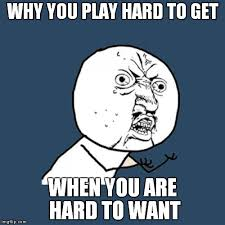
It’s your prospect who gets to do the ignoring. You better make sure you’re available whenever they call upon you for whatever.
Forms are so 2016, 2015, 2014… ‘Prehistorical’ is the word we’re looking for. Today you can have a direct line with your prospects and customers using livechat software like Intercom or Drift. This is a key element of establishing yourself as someone your leads can trust to solve their problems. They have a problem, you solve it. In real-time.
Both Intercom and Drift aren’t your everyday chat-services anymore. They have matured into intelligent specimens that can cover for you when you’re not around. At present this doesn’t go much beyond some auto-responses, but they’re getting smarter by the day.
Enable prospects to help themselves
I’m a resourceful guy. Whenever I look for a piece of information on a website, I first check out the Help or FAQ section before I’d turn to reaching out to customer support. Some people just like to find things out on their own, you know.
There’ll always be people who don’t like calling, chatting or even emailing. That doesn’t mean you can’t get them as a customer. Provide them with an elaborated self-help section, whatever that means for your product or service.
You can easily merge this tactic with your live chat support. Solving customer problems goes a lot quicker if you can refer them to articles that answer exactly the question they have. It doesn’t even have to be you the one referring them. Whenever our live chat at Salesflare isn’t manned (we sleep sometimes, you know), the bot will suggest the customer to check out articles from the HowTo section. Creating tons of content around your product is also great for SEO.
We build our HowTo section within Intercom. If you’re using Drift or something else, you can take a look at SupportHero.
And then, if we take it another step further, there’s also digital user feedback. User feedback is ideal for identifying pain points within your sales funnel, thus giving you around-the-clock insights into the customer experience. And this isn’t limited to just your website. Digital solutions such as Mopinion enable organisations to collect and analyse this feedback on multiple digital channels such as websites, mobile apps and email campaigns.
Bring it all together in your CRM
CRM systems were once conceived as a hub where all your customer relations came together. Somewhere amidst the suffering of manual data input and the likings, that essence was lost. Salesflare is our way of getting it back. One central place to bring your data together and enable you to build meaningful relations with multiple prospects at the same time, easy and effortlessly.
Whether you use Salesflare or something else, think of your CRM as your Batcave. It’s the base from where you reflect on your actions, contemplate your next move and pull the strings. The one thing that allows you to do all of that, is data.
Contact data, company info, social profiles and networks of contacts. Emails you’ve exchanged, pages on your websites they’ve visited, links they’ve clicked, phone calls you’ve had and meetings you’ve held. Your sales funnel. All in one place.
Salesflare gets you this without you having to lift a finger. But it’s only when you link it up to other tools that it becomes really powerful. In addition to all the other data, we pull in Intercom conversations, NPS scores and trial data to get a full-fledged in-depth overview of every lead and customer in our sales funnel, organized by stage.
If you think we’ve reached that stage of our relationship, here’s a CTA 👇 If not, no hard feelings.
“Love Salesflare. Simple but elegant and always improving. Love the UI. Great team to work with. Also, appreciating the Gmail integration and other 3rd party integrations.”
Lonnie Mayne, Red Shoes Living

More about CTAs in a second…
For more inspiration on how to use your CRM to win at follow-up and drive leads through your sales funnel, check out The Subtle Art Of Following Up With Automation.
#3. Action
You can go on a lot of cute dates, but eventually you want something to happen. The friend zone is a dark place to be.

You can be putting out great content over and over, at some point you’re going to need to get serious and make your move.
Make your intentions clear with CTAs
You’re flirting, you’re having a good time, they’re enjoying your stuff. But at some point this relationship has to land. You started this whole thing looking to get a commitment. It’s your responsibility to drive your prospect down the sales funnel stages towards that commitment with clear call-to-actions.
Have a goal in mind with everything you create and have your prospect lay eyes upon. Be it an email, a piece of content, a landing page or a Facebook Ad — you want your prospect to perform a certain action. Make it easy for them to do just that. You can use software like Poptin to make the CTAs on your website as attractive as possible.
Make them fearful of missing out
FOMO or ‘Fear Of Missing Out’ is more than just a pop culture buzzword. It’s a real psychological occurrence, driving behaviors in people of all sorts, especially in millennials.

As a marketer, you don’t want to miss out on FOMO to drive decisions.
Few things drive decision more than the fear of not being able to later on. Discounts are most powerful when limited in time. This is why Black Friday is the craziest shopping day of the year: the chance to finish all your Christmas shopping in one day. Not the next day, only on that day.
You need to be subtle about it though. Trying to create FOMO can give people the feeling that they’re being sold to and nobody likes that. The secret is to instill FOMO in your prospects without them being aware of it, gradually along the lines of all that value you’re giving them across channels.
Slip in some customer testimonials
Your best tactic to avoid giving people the feeling that they’re being sold to, is having someone else tell them how awesome your product is (and how sucky it would be to miss out on it). Beyond all tools, channels, hacks and techniques, the strongest driver of sales is and will always be word-of-mouth.
If you paid attention before, you’ll have noticed that there’s a customer testimonial in the example Facebook Ads retargeting sales funnel stages laid out before. Ideally, the customer testimonial represents a case many among your target audience can relate to. The testimonial then becomes both relevant value and a decision-driver to your prospect. They see someone like them solving a problem they’re having too and will start asking themselves what they are doing about that problem.
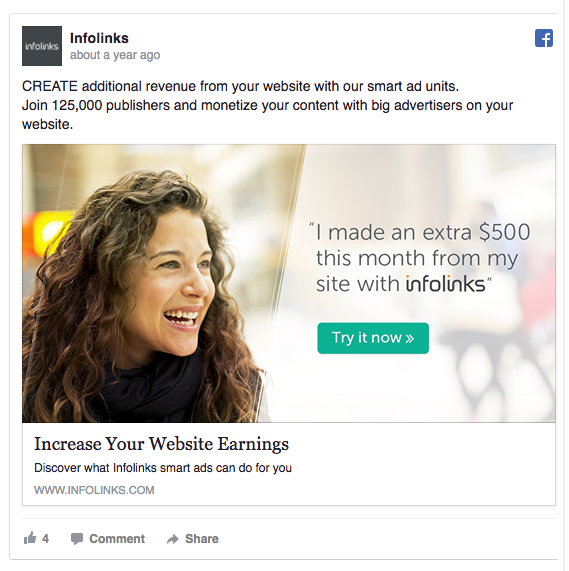
Of course, it doesn’t have to be a Facebook Ad. Testimonials are a great way to back up the claims you’re making on your landing pages too, like Unbounce is doing here.
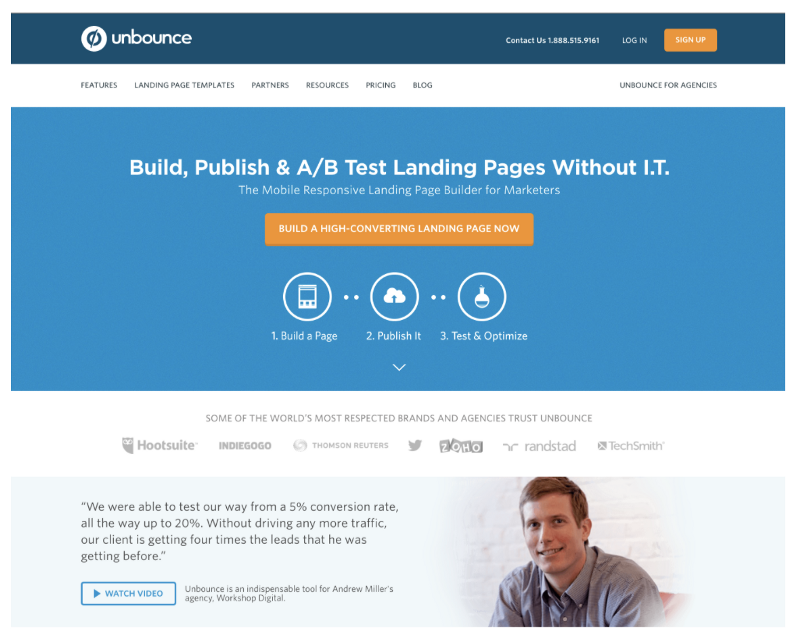
Create scarcity and urgency
The Black Friday technique. Drive decision by making prospects feel it’s ‘now or never’. It’s ‘limited’ edition. There’s ‘only a few left in stock’. This deal ‘ends tomorrow’.

You can use data to make sure you only show these kinds of deals to the people who are right there in the third stage of the sales funnel, on the tipping point of going for the purchase.
When asked about the essence of growth marketing, Sean Ellis, godfather of the concept, said:
Sustainable growth comes from understanding best customers and figuring out how to find and acquire more of them.
What this means in the context of creating urgency is that you should have a clear idea of the signs a prospect shows when they’re close to cutting the knot and just need one last push, that last push being your CTA with a limited offer.
For a SaaS product like Salesflare, you can deduct this from the actions users are performing in their trial accounts: daily activity, number of accounts created, users added to their teams. For ecommerce this can be about users returning multiple times to view a particular item.
This kind of data will tell you who to create urgency for. It’s like your date seeking a lot of eye contact and giving you little touches with every opportunity they get. It tells you that if you would make a move now, your chances of success are pretty fair.

#4. The long-term relationship
Congratulations, you’re married now.

This is not a one-time thing kind of deal. You and your prospect committed to each other and are in it for the long run.
Don’t worry, you still get to date and marry other prospects. On the condition that you honour your standing commitments, that is. Don’t get carried away chasing other prospects and neglecting existing customers, it will come back to bite you in the ass.
Driving traffic to your website isn’t hard. Getting them to sign up for your email list is fairly easy. You don’t have to be world class to get them to buy your product or subscribe to your service.
Just as with marriages, the hard part is what comes after. Keeping them happy, getting them to come back — over and over again.
Take a look at this graph on retention for Android apps Andrew Chen shared on his blog a couple of years ago.

If 100 users download your Android app, you’ll have about 20 left after three days. About 80% of those will have you left you 90 days later.
This is as much about activating users as it is about retaining them, but you get the message: you can’t afford to only focus on driving purchases to new customers. Keeping current customers happy is at least as crucial for sustainable growth.
Not convinced? How about this report from eConsultancy saying that “the probability of selling to an existing customer is 60–70 percent, while the probability of selling to a new prospect is only about 5–20 percent.”
Loyal customers are worth way more than new ones and creating loyalty takes consistent hard work just like a long and happy marriage takes consistent hard work. Don’t just engage, stay engaged.
Make sure you know how to get this right before you scale up your marketing strategies. Customers you can’t retain aren’t just gone, they’re often also not very good ambassadors of your brand. Staying friends with your ex isn’t for everyone.
Leverage your Net Promotors
“On a scale of 0 to 10, how likely are you to recommend this app to a friend or colleague?”

This question helps measure customer satisfaction and identify Net Promotors, people who like your product so much they’d happily refer it to other people.
Net Promotors are people who voted 9 or higher. 6 or lower indicates Detractors, customers that aren’t very happy with your product and are likely to file for divorce in the near future. They won’t exactly recommend you as a satisfying party to peers either.
First and foremost, NPS score will tell you if your product and retention strategy still needs work or if you’re ready to scale up and unleash marketing mayhem. It will tell you if you’re marriage material.
If you are, it may be worth encouraging your happiest partners (Net Promotors who gave you a rating of 9 and higher) to spread the word on how great of a party you are.
We hooked up NPS-software Growthscore.io with our referral software to automate outreach to Net Promotors asking if they would consider referring in exchange for commission on the sales they bring us. There’s also automated emails going out asking them if they would do us the favor of phrasing their contentment in a review on G2Crowd or Product Hunt.
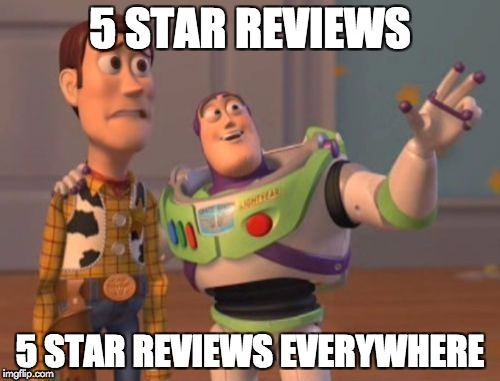
And just like that, you’ve closed the loop. Now you have happy customers pushing new prospects into the firs stage of your sales funnel.
There’s a lot more to say about making customers happy and keeping them that way. We’ll keep that for our next date 😏.
We hope you liked this post. And maybe Salesflare a bit more too. 😍
If so, here’s another CTA 😉
“I received an email from a prospect from many months ago. I was able to find him on the Opportunity pipeline, and immediately knew who he was, and where he had stopped in the pipeline.”
John Verbrugge, Shared Hands

👉 You can follow @salesflare on Twitter, Facebook and LinkedIn.
Last updated:
- The 20 Best Sales Books Elon Musk Is Probably Reading - February 14, 2023
- 6 foolproof ways to get your startup its first 100 customers - December 6, 2022
- How To Build A Sales Funnel That Sells - September 2, 2021